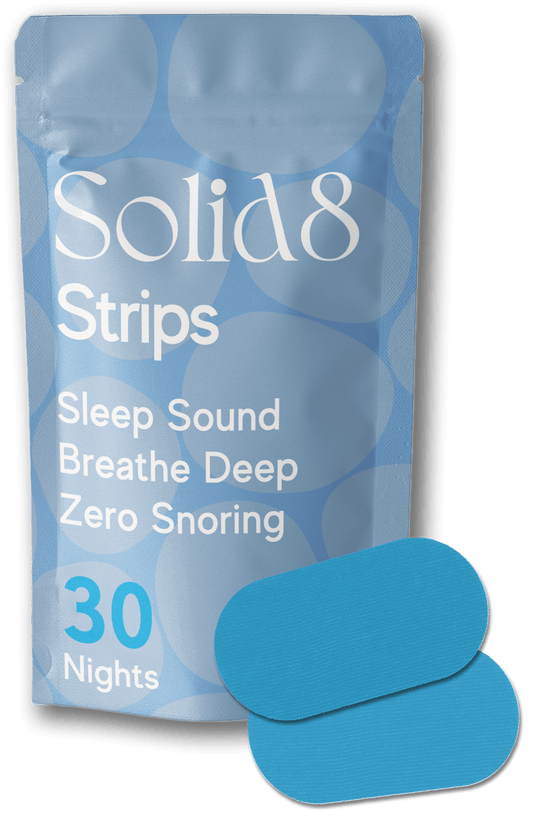
Mouth Taping and Sleep Apnea: What You Need to Know
Share
Are you waking up exhausted or gasping for air at night? Maybe you’ve heard about mouth taping as a possible solution for sleep apnea. It’s a straightforward technique where you place tape over your mouth to encourage nasal breathing while you sleep. But if you’re dealing with sleep apnea—a condition where your breathing stops and starts due to a blocked airway—you might be wondering if this could work for you. Let’s dive into what you need to know to make an informed decision.
Key Takeaways
- Mouth taping might reduce snoring and improve sleep quality for those of you with mild sleep apnea, but it’s not a proven cure.
- It’s not a substitute for medical treatments like CPAP machines or oral appliances—consult your doctor first.
- Risks include breathing difficulties, skin irritation, and discomfort, especially if your nose is blocked.
- Use safe techniques, like choosing the right tape and testing it during the day, to minimize potential issues.
What Is Sleep Apnea, and Why Does It Matter?
Sleep apnea isn’t just loud snoring—it’s a health concern you should take seriously. The most common type, obstructive sleep apnea (OSA), occurs when your throat muscles relax too much, blocking your airway. You might stop breathing for seconds or minutes, waking up to gasp for air without even realizing it. This can leave you feeling tired, irritable, or even increase your risk for heart disease over time.
Have you noticed daytime fatigue or your partner mentioning pauses in your breathing? Those are signs to watch for. Traditional treatments like CPAP machines or oral appliances are the gold standard, but mouth taping has popped up as a trendy alternative. Let’s explore if it’s worth your time.
Can Mouth Taping Help Your Sleep Apnea?
Let’s be clear: mouth taping isn’t a cure for sleep apnea. The American Academy of Sleep Medicine doesn’t endorse it as a treatment. However, if your sleep apnea is mild, you might see some perks. Breathing through your nose filters and humidifies the air, potentially keeping your airway more open and reducing snoring—a common sleep apnea symptom.
A 2015 study in the *Journal of Clinical Sleep Medicine* found that mouth taping reduced snoring in some people with mild sleep apnea, but it didn’t significantly lower their Apnea-Hypopnea Index (AHI), a measure of sleep apnea severity. So, it might quiet things down, but it’s not tackling the core issue.
Dr. Jane Smith, a sleep specialist, advises, “For some of you with mild cases, mouth taping might offer minor relief, but it’s not a replacement for proven therapies. Always check with your healthcare provider.” If your sleep apnea is moderate to severe, this isn’t the fix you’re looking for—stick with medical guidance.
Potential Risks You Should Know About
Before you try taping your mouth shut, let’s talk risks. It sounds simple, but it’s not without hazards—especially for you with sleep apnea or breathing challenges.
- Breathing Blockage: If your nose is stuffy from allergies or a cold, taping your mouth could make breathing tough. That’s dangerous when you’re asleep and can’t react quickly.
- Skin Irritation: The adhesive might irritate your skin or cause an allergic reaction—something you don’t want to wake up to.
- Discomfort: Feeling tape on your face all night can be unsettling, especially if you’re new to it.
- Missed Treatment: Relying on tape instead of proper care could let your sleep apnea worsen, raising health risks.
Here’s how to stay safe: consult your doctor before starting. Test it during the day to see how it feels, and use a small, easy-to-remove piece of tape. If your nose isn’t clear, skip it—your safety comes first.
How to Try Mouth Taping Safely
Okay, say your doctor approves mouth taping for you. How do you do it without turning sleep into a struggle? Follow these steps:
- Choose the Right Tape: Pick a gentle, hypoallergenic option. Not sure where to start? Check our Ultimate Buyer’s Guide.
- Prepare Your Skin: Wash and dry your lips and surrounding area for better adhesion and less irritation.
- Apply Correctly: Use a 1-2 inch piece vertically over your lips, leaving some flexibility to breathe if needed.
- Test During the Day: Try it while awake to ensure you can breathe comfortably through your nose.
- Keep Removal Handy: Have scissors or a tape remover nearby in case you need to peel it off fast.
- Listen to Your Body: Feel short of breath or anxious? Remove it immediately—your comfort is key.
Mouth taping isn’t one-size-fits-all. What works for someone else might not suit you, so proceed with caution and keep your doctor in the loop.
Comparing Mouth Taping to Other Solutions
You might be wondering how mouth taping stacks up against other sleep apnea fixes. Here’s a quick look:
| Solution | Effectiveness | Cost | Accessibility |
|---|---|---|---|
| Mouth Taping | Mild snoring relief, not for severe cases | Low (~$0.40-$0.80/strip) | Over-the-counter, easy to try |
| CPAP Machine | Highly effective for all levels | High ($500-$3000+) | Requires prescription, setup |
| Oral Appliances | Effective for mild to moderate cases | Medium ($1500-$2000) | Custom-fitted by dentist |
For you with mild sleep apnea, mouth taping might be a low-cost starting point, but for moderate to severe cases, CPAP machines or oral appliances are the way to go. Talk to your doctor to find your best fit.
Conclusion
So, what’s the verdict for you? Mouth taping might ease mild sleep apnea symptoms like snoring, but it’s not a cure—and it comes with risks you can’t overlook. For serious cases, stick with proven treatments and consult your healthcare provider.
At Solid8 Sleep, we’re here to support your journey to better rest. Check out our sleep products to find tools that work for you. Use code RESTFUL for 10% off your first order. Ready to transform your sleep? Start today!


